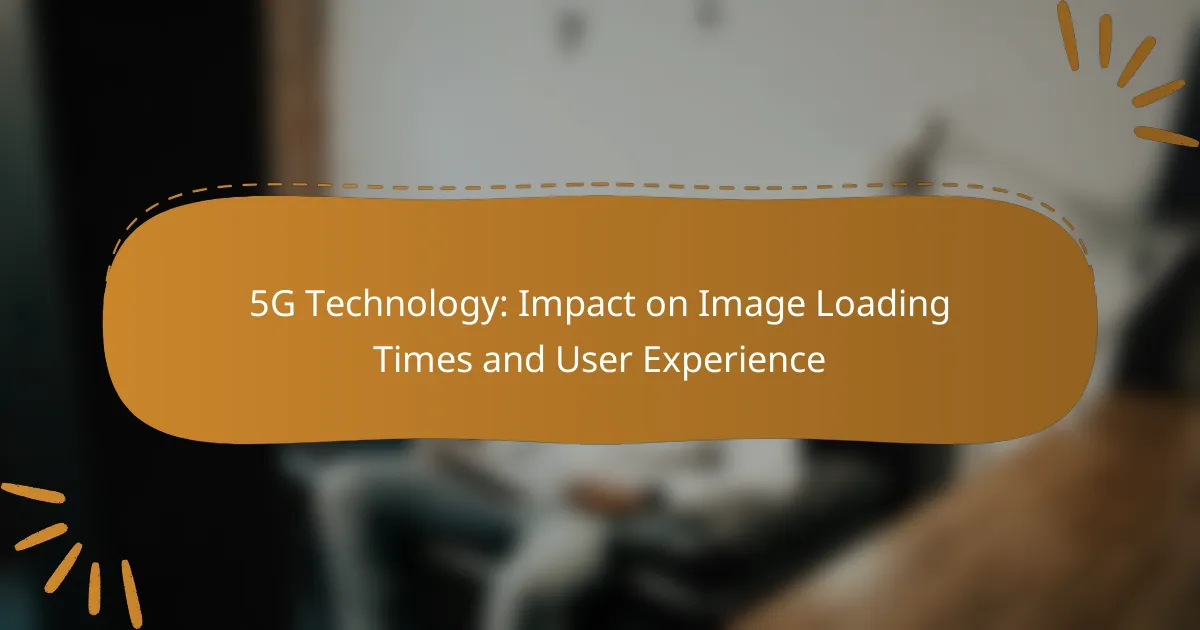5G technology revolutionizes image loading times by delivering faster data transfer rates and reduced latency, resulting in a noticeably improved user experience. With its enhanced bandwidth, users can access images almost instantaneously, making it essential for applications that rely heavily on visual content. This advancement is particularly impactful in urban areas, where mobile connectivity and speed are crucial for seamless interaction.
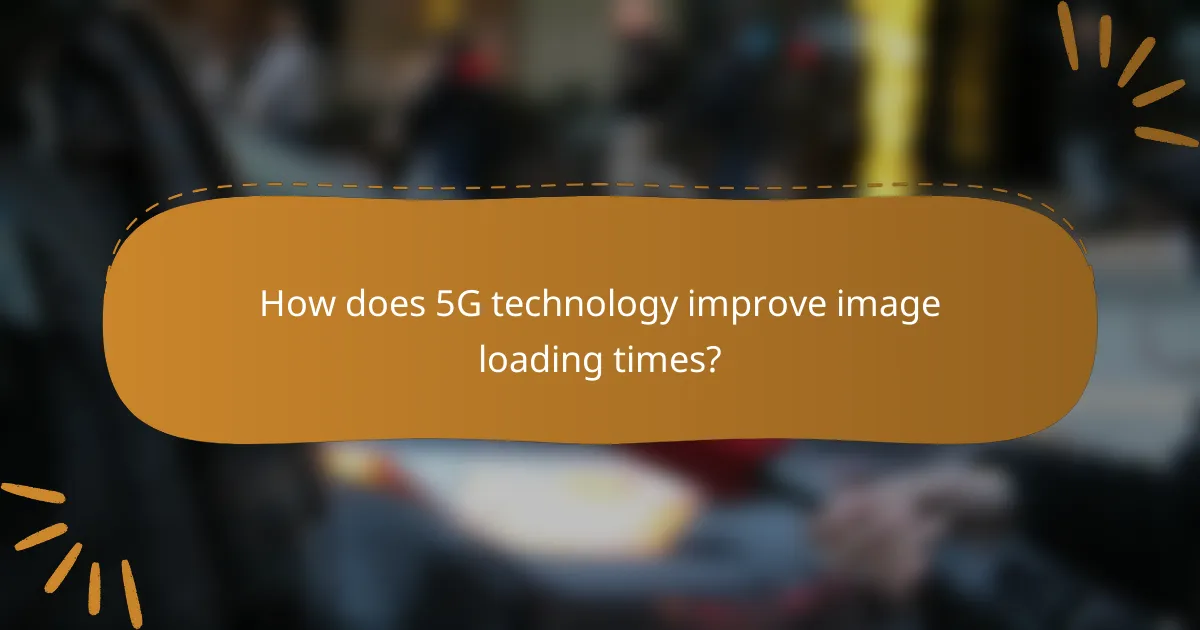
How does 5G technology improve image loading times?
5G technology significantly enhances image loading times by providing faster data transfer rates, reduced latency, and enhanced bandwidth. These improvements lead to quicker access to images and a smoother overall user experience on mobile devices.
Faster data transfer rates
5G networks can achieve data transfer rates that are several times faster than 4G, often reaching speeds of up to 10 Gbps under optimal conditions. This increase allows users to download high-resolution images almost instantaneously, which is particularly beneficial for applications that rely on rich media content.
For instance, while a 4G connection might take several seconds to load a high-definition image, 5G can reduce that time to mere milliseconds. This rapid loading capability enhances user satisfaction and engagement on platforms that prioritize visual content.
Reduced latency
Latency refers to the delay before data begins to transfer after a request is made. 5G technology dramatically reduces latency to as low as 1 millisecond, compared to the 30-50 milliseconds typical of 4G networks. This minimal delay means that images start loading almost immediately after a user clicks to view them.
The reduction in latency is especially crucial for real-time applications, such as video conferencing or online gaming, where quick image rendering is essential for a seamless experience. Users can expect a more responsive interaction with content, leading to higher retention rates.
Enhanced bandwidth
5G networks offer significantly greater bandwidth compared to their predecessors, allowing more data to be transmitted simultaneously. This increased capacity means that multiple users can access high-quality images without experiencing slowdowns or buffering.
In practical terms, this means that during peak usage times, such as at concerts or sporting events, users can still upload and download images quickly. Enhanced bandwidth supports the growing demand for high-resolution images and video streaming, ensuring that users can enjoy a rich media experience without interruptions.
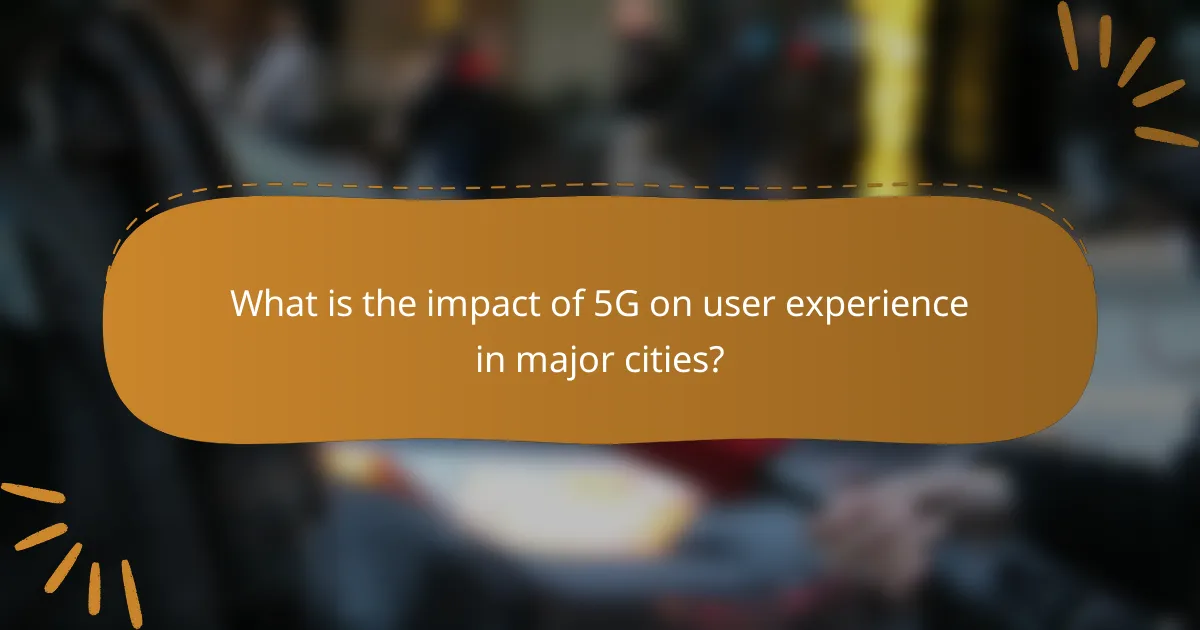
What is the impact of 5G on user experience in major cities?
The impact of 5G on user experience in major cities is significant, enhancing connectivity and speed for mobile users. This technology enables faster data transfer rates, reduced latency, and improved overall performance for various applications.
Improved mobile browsing speed
5G technology dramatically increases mobile browsing speed, allowing users to load web pages in just a few seconds. With speeds that can exceed 1 Gbps, users experience minimal delays when accessing content-rich sites or streaming services.
This improvement means that users can quickly download large files, view high-resolution images, and engage with interactive content without frustrating wait times. In urban environments where 4G networks may become congested, 5G provides a reliable alternative.
Higher quality streaming
With 5G, streaming quality reaches new heights, offering ultra-high-definition (UHD) content with minimal buffering. Users can enjoy 4K and even 8K video streams seamlessly, enhancing the viewing experience for movies, sports, and live events.
The increased bandwidth also supports multiple streams simultaneously, making it easier for families or groups to watch different content on various devices without sacrificing quality. This is particularly beneficial in densely populated areas where network demand is high.
Seamless app performance
5G enhances app performance by significantly reducing latency, which is crucial for real-time applications like gaming and video conferencing. Users can expect near-instantaneous responses, which improves interaction and engagement with apps.
Additionally, the increased capacity of 5G networks allows for smoother operation of data-heavy applications, such as augmented reality (AR) and virtual reality (VR). This means users can enjoy immersive experiences without interruptions, making 5G a game-changer for app developers and users alike.

How does 5G compare to 4G in image loading?
5G technology significantly enhances image loading times compared to 4G, enabling faster data transmission and improved user experience. Users can expect images to load almost instantaneously, which is crucial for applications relying on visual content.
Significant speed increase
5G networks can deliver data speeds that are several times faster than 4G, often exceeding 1 Gbps under optimal conditions. This speed allows for high-resolution images to be downloaded quickly, reducing the time users spend waiting for content to appear.
For instance, while a 4G connection might take several seconds to load a high-definition image, 5G can accomplish the same task in fractions of a second. This improvement is particularly beneficial for applications like streaming services and social media platforms where image quality is paramount.
Lower buffering times
With 5G, buffering times are drastically reduced, enhancing the overall user experience. Users can expect latency to drop to low tens of milliseconds, which minimizes interruptions when loading images or switching between content.
This reduction in buffering is critical for real-time applications such as video calls or online gaming, where delays can disrupt communication and gameplay. As a result, users can enjoy seamless interactions without the frustration of waiting for images to load.

What are the challenges of implementing 5G technology?
Implementing 5G technology presents several challenges, primarily related to infrastructure costs and coverage limitations. These challenges can impact the speed and efficiency of deployment, affecting overall user experience.
Infrastructure costs
The infrastructure costs associated with 5G deployment can be significant. Building new cell towers and upgrading existing ones requires substantial investment, often running into millions of dollars per site. Additionally, the need for fiber optic cables to connect these towers adds to the financial burden.
Telecommunications companies must weigh the costs against potential revenue from increased data usage and new services. In many cases, partnerships with local governments or private investors can help mitigate these expenses, but securing funding can be a lengthy process.
Coverage limitations
Coverage limitations are a critical challenge for 5G technology. While 5G can offer faster speeds and lower latency, its higher frequency signals have a shorter range and are more susceptible to obstacles like buildings and trees. This means that extensive infrastructure is necessary to ensure consistent coverage.
Urban areas may see quicker rollouts due to higher population density and demand, while rural regions could experience delays. To address this, companies often deploy small cells to enhance coverage in hard-to-reach areas, but this adds complexity and cost to the implementation process.
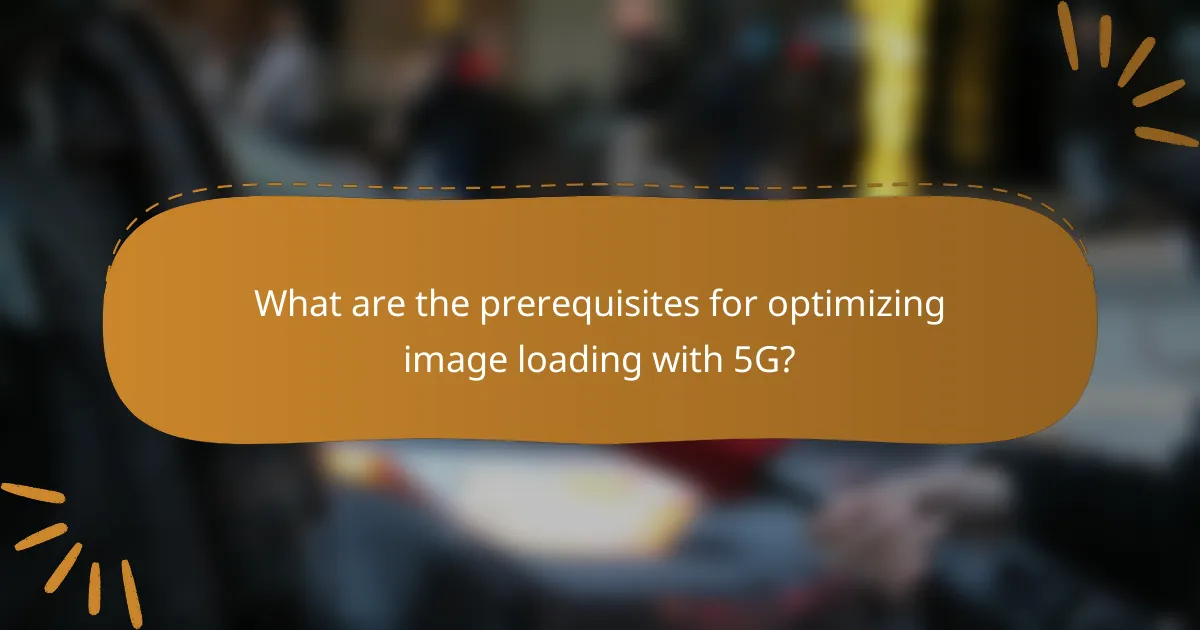
What are the prerequisites for optimizing image loading with 5G?
To optimize image loading with 5G technology, users need compatible devices and updated software. These prerequisites ensure that the full potential of 5G’s high speeds and low latency can be utilized for faster image rendering and improved user experiences.
Compatible devices
Devices must support 5G networks to take advantage of the enhanced image loading capabilities. This includes smartphones, tablets, and laptops equipped with 5G modems. Many newer models from major manufacturers are designed to be 5G compatible, but older devices may require upgrades or replacements.
When selecting a device, check for compatibility with the specific 5G bands used in your region, as different countries may have varying standards. For example, devices that support both sub-6 GHz and mmWave frequencies can offer broader coverage and faster speeds.
Updated software
Keeping your device’s operating system and applications updated is crucial for optimizing image loading with 5G. Software updates often include performance enhancements and bug fixes that can significantly improve how images are processed and displayed. Regularly check for updates to ensure you are using the latest versions.
Additionally, consider using browsers and apps that are optimized for 5G. Some applications may offer settings specifically designed to leverage 5G speeds, allowing for faster image loading and a smoother overall experience. Always review app permissions and settings to maximize performance.
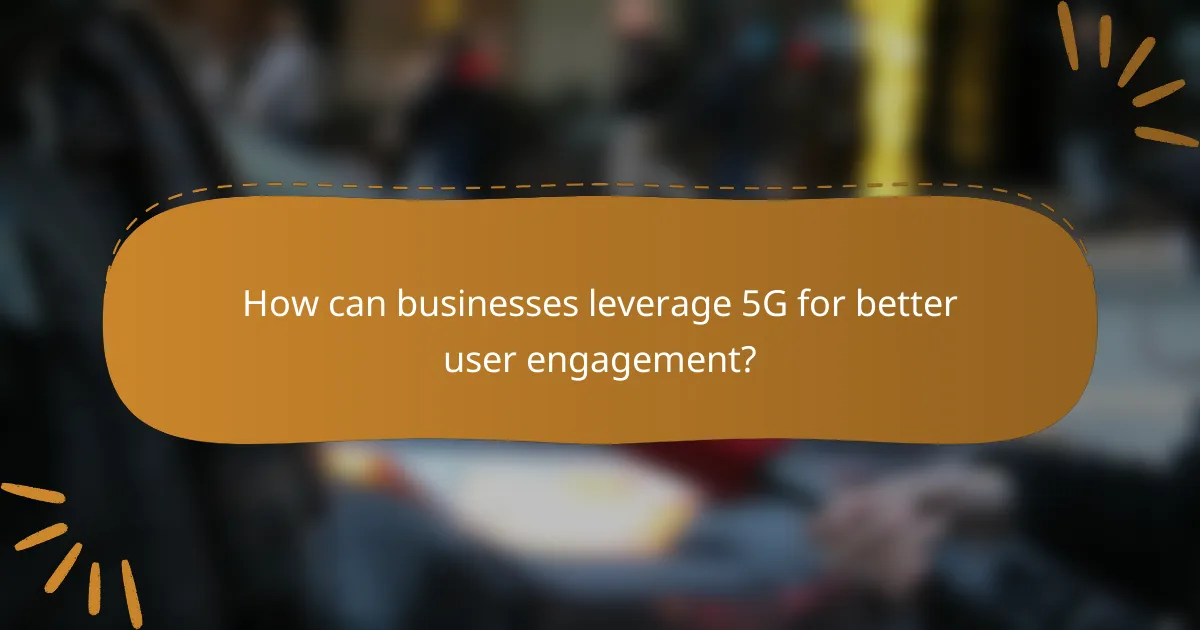
How can businesses leverage 5G for better user engagement?
Businesses can leverage 5G technology to enhance user engagement by utilizing faster data speeds and lower latency. This allows for more dynamic content delivery and improved interactive experiences, ultimately leading to higher customer satisfaction and retention.
Enhanced advertising strategies
5G enables businesses to implement enhanced advertising strategies by delivering rich media content more efficiently. Advertisements can load faster, reducing wait times and increasing the likelihood of user interaction. For example, video ads can be streamed in high definition without buffering, capturing user attention effectively.
To maximize the impact of advertising, consider using targeted ads that leverage real-time data analytics. This allows businesses to tailor messages based on user behavior and preferences, making ads more relevant and engaging. Avoid generic campaigns; instead, focus on personalization to drive better results.
Interactive content delivery
With 5G, interactive content delivery becomes seamless, allowing businesses to create immersive experiences such as augmented reality (AR) and virtual reality (VR). These technologies can be integrated into apps and websites, providing users with engaging ways to interact with products and services.
For instance, a retail brand could use AR to let customers visualize how furniture would look in their homes before making a purchase. To effectively implement interactive content, ensure that your platform is optimized for mobile use and can handle the increased data demands of 5G. Regularly test and refine these experiences to maintain high user satisfaction.
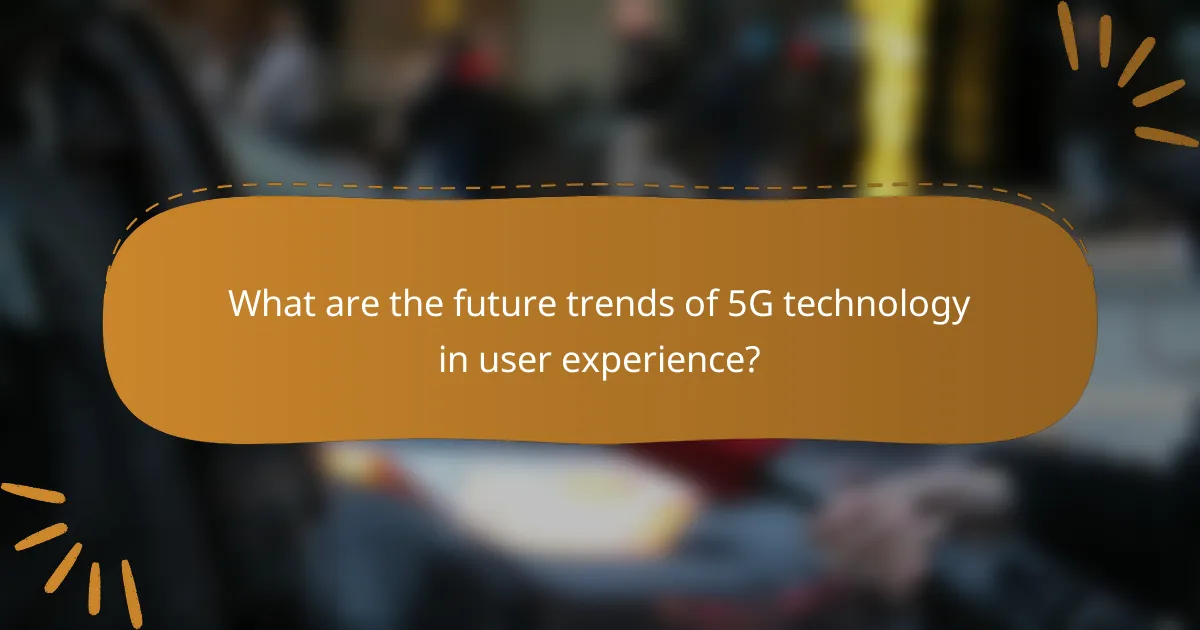
What are the future trends of 5G technology in user experience?
The future trends of 5G technology are set to significantly enhance user experience by providing faster data speeds, lower latency, and improved connectivity. As 5G networks continue to expand, users can expect more seamless interactions with digital content, particularly in areas like image loading times and streaming services.
Enhanced Image Loading Times
5G technology dramatically reduces image loading times compared to previous generations. With speeds potentially reaching up to 10 Gbps, users can expect images to load in fractions of a second, enhancing the overall browsing experience.
This improvement is particularly beneficial for mobile users who rely on quick access to visual content. For instance, high-resolution images and videos can be streamed without buffering, making applications like social media and e-commerce more efficient and engaging.
Impact on Streaming Services
Streaming services will benefit immensely from 5G’s capabilities, allowing for higher quality video content without interruptions. Users can enjoy 4K and even 8K streaming with minimal latency, which is a significant upgrade from the current limitations of 4G networks.
As more users adopt 5G, platforms may also introduce features such as interactive streaming and augmented reality experiences that require high bandwidth and low latency. This shift will create new opportunities for content creators and advertisers to engage audiences more effectively.
Increased Connectivity for IoT Devices
The proliferation of Internet of Things (IoT) devices will be accelerated by 5G technology, leading to a more connected user experience. With 5G’s ability to support a vast number of devices simultaneously, users can expect seamless integration of smart home devices, wearables, and connected vehicles.
This connectivity will enhance user experience by enabling real-time data sharing and automation. For example, smart home systems can respond instantly to user commands, and wearables can provide immediate health insights, making daily tasks more efficient.
